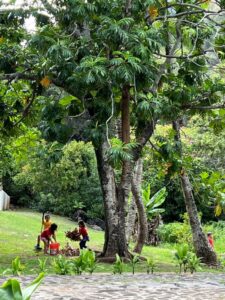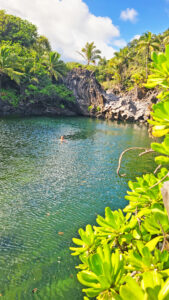Biologist’s 15-year study focuses on Iao Stream’s freshwater species
Although 10 million gallons of water per day has been returned to Iao Stream since October, it is hard to tell so far if more freshwater species are flourishing, said Skippy Hau, an aquatics biologist with the state Department of Land and Natural Resources.
There may be a time “lag” in how the addition of more water could impact freshwater species such as fish, or ‘o’opu (gobies); shrimp, or ‘opae; and snails, or hihiwai, said Hau, a longtime official in the department’s Division of Aquatic Resources.
But data Hau collected in his 15-year study of Iao Stream animals reinforced his belief that “when you put water in the streams, animals will come back naturally.”
From 2000 to 2014, Hau randomly collected 27,669 stream animals with a small fish net. This included three different types of ‘o’opu (for a total of 2,341, or 8.4 percent of the animals caught), one type of ‘opae (24,369 caught, 88 percent), Tahitian prawn (863, or 3 percent) and aholehole (96, or a small fraction of a percent). These were collected in the channel area near Sack N Save in Waiehu.
Hau presented data from his study Tuesday afternoon at the 52nd annual Association for Tropical Biology and Conservation 2015 Conference held at the Hawaii Convention Center on Oahu. He also made appearances on Oahu morning television news shows.
In his summary of his presentation, Hau said the study shows that stream flow transports hatched larvae to the ocean and allows returning post larvae to migrate upstream.
Continuous stream flow has increased stream productivity, with more larvae reaching the ocean and more stream habitat available in lower Iao Stream.
Hau’s Iao Stream study comes several months after 10 million gallons of water per day began being returned to the stream, the result of a contested case agreement.
Wailuku Water Co. agreed to restore 10 million gallons per day to Iao in a settlement approved by the Commission on Water Resource Management in April 2014. The company also pledged to return 2.9 mgd to Waikapu Stream. The water was released in October.
Water from the Iao, Waikapu and Waiehu streams along with Waihee River, collectively known as Na Wai Eha, or the four great streams of Central Maui, have been diverted for more than 100 years by Wailuku Sugar Co. Its descendant company, Wailuku Water Co., for years has been stuck in legal issues as Native Hawaiians, environmentalists and local farmers have sought the release of more water restored to Na Wai Eha.
Those fighting for more water have been successful, but they say more work needs to be done.
While stream flows make a difference, so do rainy weather conditions, Hau said.
From 2000 to 2006, rainfall in the Iao Stream area was about average, Hau said. But from 2007 to 2013, rainfall was below average. The rain apparently impacted the ‘opae numbers, Hau said.
From 2000 to 2006, the numbers of ‘opae collected ranged from a low of 543 in 2003 to a high of 2,850 in 2001. From 2000 to 2002, numbers of ‘opae were in the 2,000 range.
From 2007 to 2013, data ranged from a low of 568 ‘opae in 2007 to a high of only 2,447 in 2012. No other year found more than 2,000 ‘opae caught by Hau’s small fish net.
Last year yielded the highest number of ‘opae collected at 3,794.
For several species of ‘o’opu that need to swim upstream to grow as adults after developing in the ocean, Hau would perform an “assist” and take the species in a 5-gallon bucket from the collection site near Sack N Save up to near the Iao needle in Iao Valley. There he would let nature take its turn and have the species go farther upstream on its own to complete its life cycle.
Several species of ‘o’opu have fused pelvic fins that are used like suction cups to help them get upstream. The ‘o’opu uses its fins to grab onto rocks and the streambed to travel upward. Sometimes it may travel miles to the headwaters of a stream, according to a DLNR news release.
Hau’s research shows that, even with streams with little to no surface flow, because of diversions, groundwater often continues to provide an estuary with enough fresh flow to ensure continued recruitment (return) of fish, shrimp and snails, a news release said.
In addition to his Iao Stream study, Hau has been recording movements of the hihiwai on Maui, which hatch from eggs in the stream and then as larvae flow out to the ocean where they develop further. They then migrate back to land and crawl up streams and waterfalls to where they grow into adults, a news release said.
The hihiwai leave a mucus trail and follow one another upstream.
Hau also has been studying freshwater species in East Maui streams.
Like the Central Maui streams, 27 East Maui streams have been involved in a contested case over interim stream flow standards that just concluded.
The state DLNR said Tuesday that the parties involved (including East Maui Irrigation Co., a subsidiary of Alexander & Baldwin, which operates the stream diversions) are waiting for hearings transcripts.
The parties also include East Maui residents, Maui Tomorrow Foundation and Maui County (because the county water system is dependent on the East Maui water). After receiving the transcripts, the parties in the contested case proceeding will file their proposed findings of fact, DLNR said.
The hearings officer will review those documents and issue his findings of fact and conclusion of law.
There is no date set on that final determination, DLNR said.
* Melissa Tanji can be reached at mtanji@mauinews.com.





